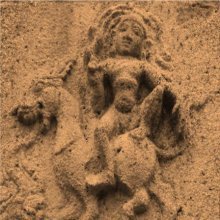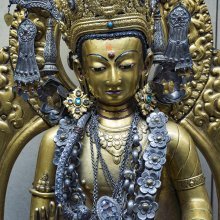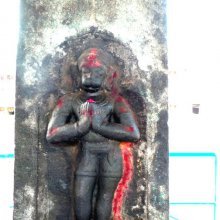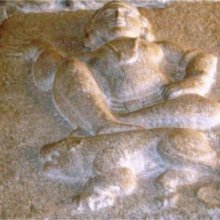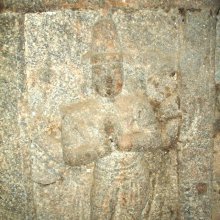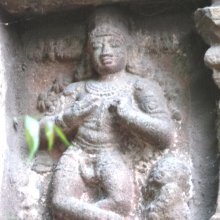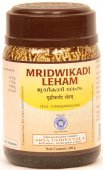Chest, Chesht, Cheṣṭ: 3 definitions
Introduction:
Chest means something in Hinduism, Sanskrit. If you want to know the exact meaning, history, etymology or English translation of this term then check out the descriptions on this page. Add your comment or reference to a book if you want to contribute to this summary article.
Images (photo gallery)
(+187 more images available)
In Hinduism
Gitashastra (science of music)
Source: Shodhganga: Elements of Art and Architecture in the Trtiyakhanda of the Visnudharmottarapurana (gita)The Chest (in Sanskrit: Uras) refers to one of various Organs of Utterance (sthāna), according to the Viṣṇudharmottarapurāṇa, an ancient Sanskrit text which (being encyclopedic in nature) deals with a variety of cultural topics such as arts, architecture, music, grammar and astronomy.—During the practise of Vocal Music, the proper production of the concerned sound is always considered as very important. Sthāna or ucchāraṇasthāna is the place of articulation of sound. Bhattojidīkṣita in his Siddhāntakaumudī said about ten kinds of sthāna (i.e., the organs of utterance), e.g., uras (chest).
Gitashastra (गीतशास्त्र, gītaśāstra) refers to the ancient Indian science of Music (gita or samgita), which is traditionally divided in Vocal music, Instrumental music and Dance (under the jurisdiction of music). The different elements and technical terms are explained in a wide range of (often Sanskrit) literature.
Natyashastra (theatrics and dramaturgy)
Source: Shodhganga: Elements of Art and Architecture in the Trtiyakhanda of the Visnudharmottarapurana (natya)The Chest refers to one of the major Body Parts with which are associated various gestures and expressions (in Sanskrit Dramas), as conveyed through Āṅgikābhinaya: one of the four divisions of Abhinaya or “ways to convey or represent one’s emotion to others”, according to the Nāṭyaśāstra and the Viṣṇudharmottarapurāṇa, an ancient Sanskrit text which (being encyclopedic in nature) deals with a variety of cultural topics such as arts, architecture, music, grammar and astronomy.—The āṅgikābhinaya includes the histrionic representation of the limbs which is simply known as physical gestures. The aṅgas i.e., major classification of the body parts are six in numbers viz., head, hands, chest, sides, waist and feet.
In the Viṣṇudharmottarapurāṇa, seven types of movements of the head are recorded. These are termed as:
- ākasmika,
- kampita,
- udyuta,
- vidhuta,
- parivāhita,
- udvāhita and
- abadhuta.

Natyashastra (नाट्यशास्त्र, nāṭyaśāstra) refers to both the ancient Indian tradition (shastra) of performing arts, (natya—theatrics, drama, dance, music), as well as the name of a Sanskrit work dealing with these subjects. It also teaches the rules for composing Dramatic plays (nataka), construction and performance of Theater, and Poetic works (kavya).
Yoga (school of philosophy)
Source: ORA: Amanaska (king of all yogas): A Critical Edition and Annotated Translation by Jason BirchThe Chest in Sanskrit is denoted by the term Uras, according to the Mataṅgapārameśvaratantra (Mataṅgapārameśvara’s Yogapāda) verse 2.23-27.—In later Tantras, various details [such as fixing the eyes on some object] often preceded the verses on the seated postures, thereby indicating that the position of the hands, torso and gaze was ancillary to all of the prescribed postures. In the Mataṅgapārameśvara, these postural ancillaries [making use of the chest] constitute what they call a karaṇa, and when it is combined with a seated pose, the Yogin’s posture becomes just as complicated as any seated pose described in later medieval yoga texts.

Yoga is originally considered a branch of Hindu philosophy (astika), but both ancient and modern Yoga combine the physical, mental and spiritual. Yoga teaches various physical techniques also known as āsanas (postures), used for various purposes (eg., meditation, contemplation, relaxation).
See also (Relevant definitions)
Starts with: Cheshta, Cheshtaka, Cheshtakrita, Cheshtamana, Cheshtana, Cheshtanasha, Cheshtanirupana, Cheshtima, Cheshtita, Chestnut, Chestnut of the maranhao.
Ends with: Broadened chest, Raised chest, Sachesht, Vichesht, Wide chest.
Full-text (+919): Shrivatsa, Vakshas, Vaksha, Urograha, Bhujantara, Shadja, Uroghata, Kaustubha, Uras, Ghantu, Vaksh, Ura, Mandusa, Parshvashula, Uradukhi, Urasija, Peti, Vakshoja, Shrivrikshaka, Baradana.
Relevant text
Search found 232 books and stories containing Chest, Chesht, Cheṣṭ; (plurals include: Chests, Cheshts, Cheṣṭs). You can also click to the full overview containing English textual excerpts. Below are direct links for the most relevant articles:
Garga Samhita (English) (by Danavir Goswami)
Verse 3.10.5 < [Chapter 10 - The Glory of Śrī Girirāja]
Verse 5.8.47 < [Chapter 8 - The Killing of Kaṃsa]
Verse 6.1.24 < [Chapter 1 - Jarāsandha’s Defeat]
Sahitya-kaumudi by Baladeva Vidyabhushana (by Gaurapada Dāsa)
Text 10.54 < [Chapter 10 - Ornaments of Meaning]
Text 7.162 < [Chapter 7 - Literary Faults]
Text 10.214 < [Chapter 10 - Ornaments of Meaning]
Stage < [July – September, 2000]
The Heart of the Poor Cattle-keeper < [April – June, 1980]
The Heart of Poor Cattle-Keeper < [November, 1928]
Matangalila and Hastyayurveda (study) (by Chandrima Das)
Avapāta: The fifth technique < [Chapter 3]
The merits and measures of food suitable for the Elephant < [Chapter 3]
Capturing of elephants in battle-field < [Chapter 2]
Kathasaritsagara (the Ocean of Story) (by Somadeva)
The “entrapped suitors” motif < [Notes]
Note on the “external soul” motif < [Notes]
Note on the “letter of death” motif < [Notes]
Heimskringla (by Snorri Sturlson)
Part 45 - Bue Throws Himself Overboard < [Chapter VI - King Olaf Trygvason's Saga]
Part 31 - Of Eystein And Inge < [Chapter XIV - Saga Of Sigurd, Inge, And Eystein, The Sons Of Harald]
Part 7 - King Magnus Taken Prisoner < [Chapter XIII - Saga Of Magnus The Blind And Of Harald Gille]
Related products
(+15 more products available)
